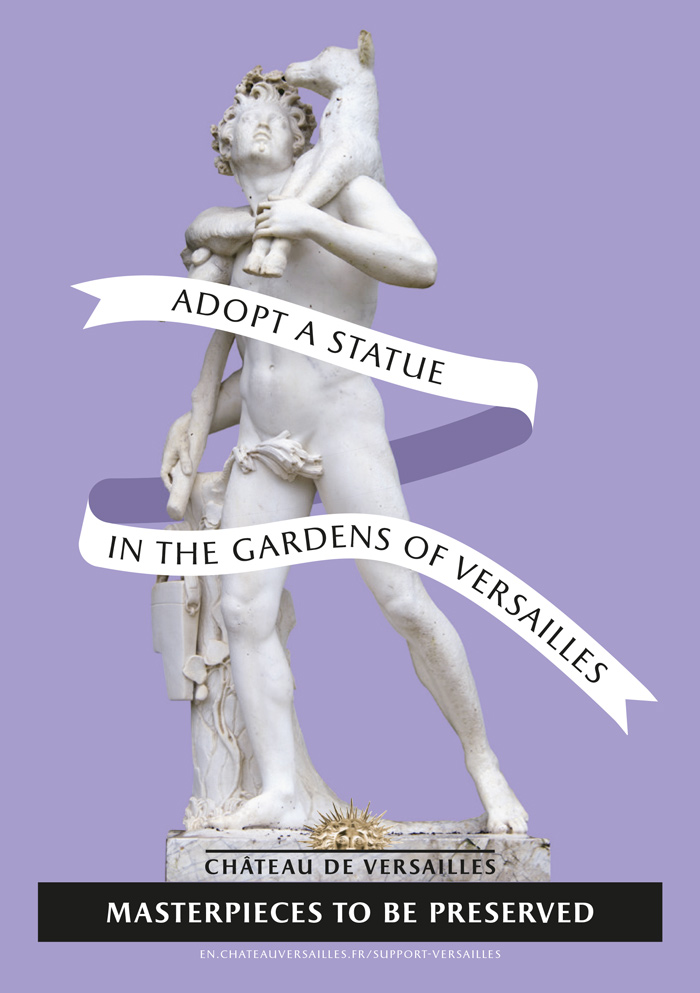Extending the lines and perspectives of the Palace, the garden commissioned by Louis XIV and created by André Le Nôtre aims to reunite art and nature. The 320 sculptures that inhabit these gardens make Versailles one of the largest outdoor sculpture museums in the world.

Adopt a statue in the gardens of Versailles
ENABLING THIS HERITAGE TO CONTINUE WITHSTANDING THE PASSAGE OF TIME
VERSAILLES, AN OUTDOOR SCULPTURE MUSEUM
Extending the lines and perspectives of the Palace, the garden commissioned by Louis XIV and created by André Le Nôtre aims to reunite art and nature. The 320 sculptures that inhabit these gardens make Versailles one of the largest outdoor sculpture museums in the world.
This decor, sculpted in white marble, mixing antique statues and works by the greatest artists of the 17th century, takes visitors on a poetic journey where gods and heroes of ancient mythology stand alongside allegorical representations of Man’s humors, the poetics genres and the continents. Although largely untouched since its creation, this heritage admired by millions of visitors every year has suffered from the ravages of time and adverse weather.
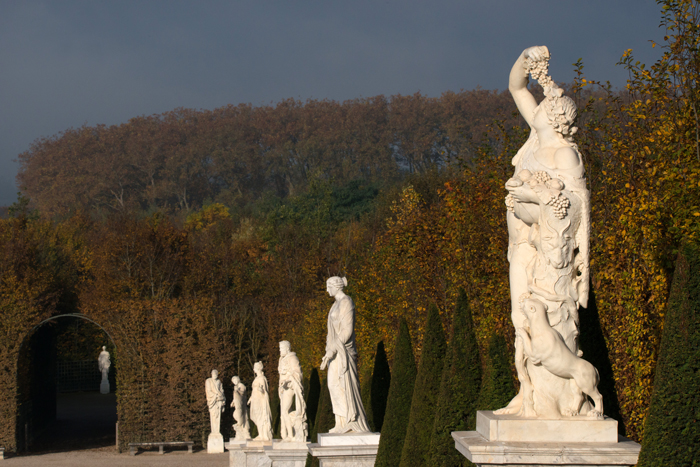
STATUES TO PRESERVE
Since 2005, a large-scale restoration program has been implemented in order to preserve this unique heritage.
Thanks to the lastest adoption campain launched in 2016, more than twenty statues from the 17th century have been restored and found shelter inside the Palace. However, several sculptures are still waiting for their replicas to be made in order to complete the gardens of Versailles.
BECOME A PATRON
The creation of a replica costs 45,000 €.
By financing one and/or the other of these operations, you will be entitled to a tax relief as well as custom-made consideration and invited to a private visit of the restoration workshop and the Sculptures and Mouldings Gallery of Versailles. Furthermore, your name will feature on a plaque featured at the foot of the restored original statue or its copy.
| You are | An individual paying tax in France | A company with a subsidiary in France |
| Your patronage | 45,000 € | 45,000 € |
| Tax relief | 66% | 60% |
| Actual cost after tax relief | 15,300 € | 18,000 € |
If you would like to participate and patron, in part, the replica of a statue, you can get in touch with the Friends of Versailles who bring together donators wishing to make a contribution, even if modest, towards projects aiming to restore or enrich the collections of the Palaces of Versailles and Trianon.
Choose your statue by downloading the brochure enclosed and get in touch with the Patronage Department.
lionel arsac and alexandre maral testimonies
Heritage curators at the Department of Sculptures and Preventive Conservation of the Palace of Versailles collections, Lionel Arsac and Alexandra Maral comment on the replica technique thanks to which 150 sculptures, out of around 320 in the gardens, are now in a safer place.
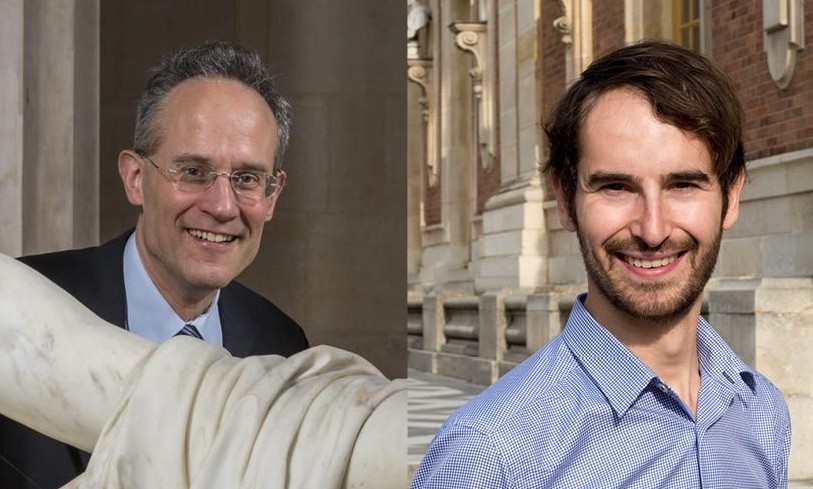
Alexandre Maral, Heritage curator and Head of the Department of Sculptures (left). © EPV / Christophe Fouin
Lionel Arsac, Heritage curator at the Department of Sculptures (right). © EPV / Thomas Garnier
Why was the decision taken to make replicas of the statues and conserve the original works in the Gallery of Sculptures and Casts and in the Palace (lower vestibule of the Royal Opera House, Lower Gallery etc.)?
The sculptures in the Versailles and Trianon gardens are an extraordinary part of our heritage, because the greatest sculptors from French and Italian schools deployed their talent to outperform each other when fulfilling commissions from Louis XIV. This heritage is fragile. Apart from vandalism, both recent and ancient, the marble works have been eroded by rain, atmospheric pollution and wind blowing sand. Once the surface has eroded, damage becomes exponential. Despite progress in restoration techniques, we cannot prevent natural phenomena, so it is our duty to conserve these masterpieces in a safer place and to replace them with replicas in the gardens.
What is the point of a replica statue with respect to conservation?
Replication techniques implemented by the moulding workshop of the Réunion des Musées Nationaux (RMN) draw on a wealth of experience in this sphere. So the replica is faithful to the original to within a micron. We prefer to make a mould rather than a sculpted copy, because sculpting does not allow for the reproduction of all the details of the works. Moulding also means we can keep records of alterations and thus the history of the work. This is essential because France signed the Venice Charter which specifically recommends conserving the state of the work without seeking to restore it to a former state we know nothing of.
How has patronage helped you conserve these works of art?
Patronage is essential. Without American patronage from the Versailles Foundation in 2007, the group sculpture Apollo served by the nymphs, the ultimate masterpiece of French sculpture from the 17th century (the “great century” in French history) could not have been saved. Since then, half of the budget allocated to sheltering the sculptures has been funded by the Public Establishment of Versailles, the rest by our patrons. So they are absolutely indispensable.
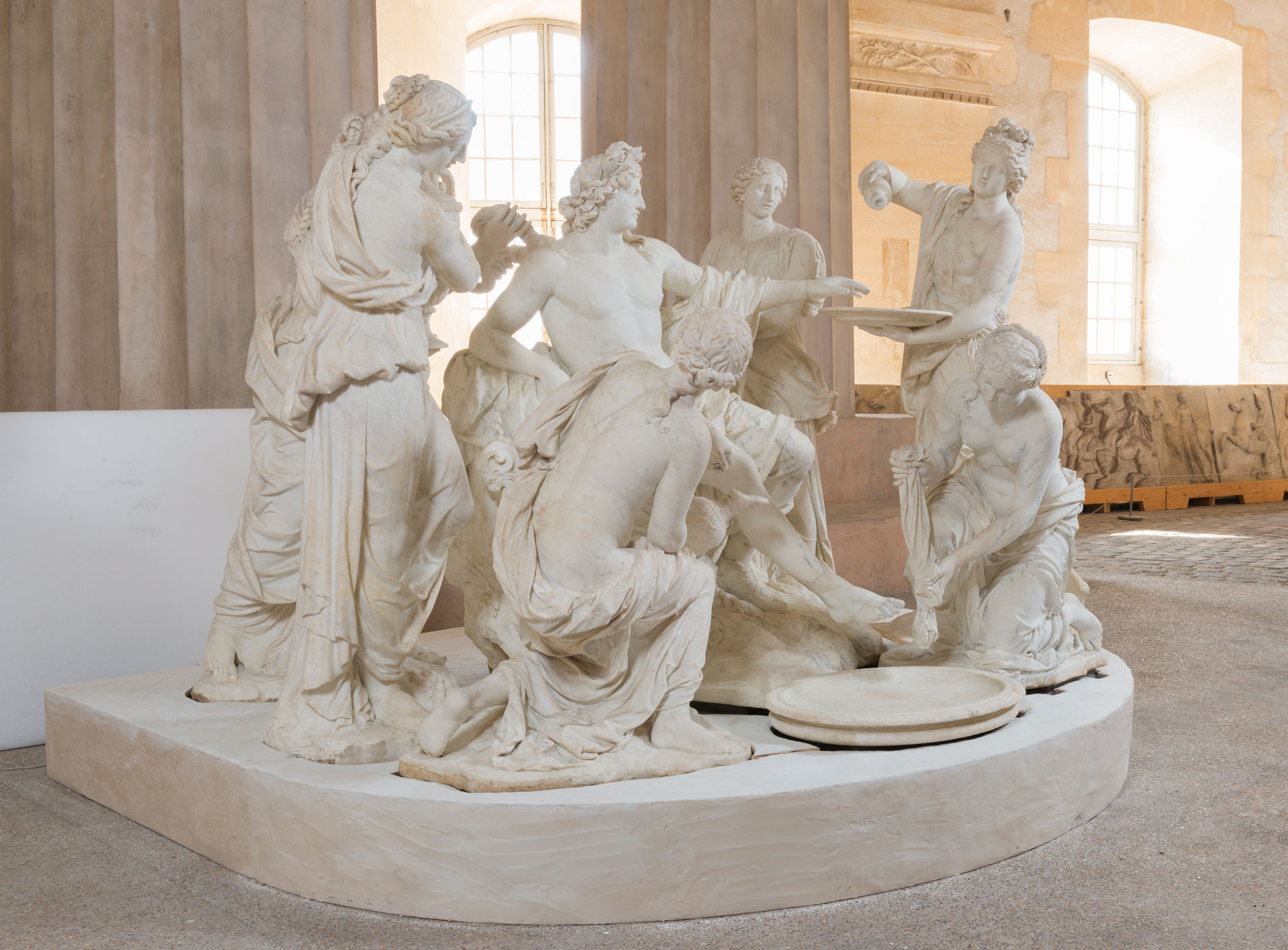
François Girardon and Thomas Ragnaudin, Apollo served by the nymphs, 1666-1672, MR. 1866
© EPV / Christophe Fouin
How do you go about replicating a statue?
First of all, the original work is brought to the Sculpture restoration workshop where it is restored and prepared for moulding. Replicating a sculpture is a highly technical process, so we work with the top statuary moulders from the RMN moulding workshop. We make a mould of the work in silicone elastomer, which can be complicated when the works feature all sorts of details and protrusions. This layer starts out fairly liquid and soft, then solidifies to form a 3D picture of the work. The next step is to make the mould and its skin to make it easier to handle. Lastly, a partner firm to the moulding workshop, Atelier Prométhée, casts a mixture of resin and marble powder in the mould. This mixture was developed especially for Versailles. The only difference between the replica and the original work is the absence of veins, which we cannot reproduce. However, we do specify that it is a replica on the cartel in the gardens, and we also mention the name of the patron who contributed to the restoration and/or sheltering of the original work.
Have you planned to make replicas of the statues in Versailles?
The Conservation Department does not envisage putting the entire collection indoors. Works have been selected for their artistic and historic importance and their fragility or state of alteration. Lastly, a team of restorers is specifically monitoring this collection, being in charge of its maintenance and other preventive conservation missions. The idea is to maintain this heritage on an ongoing basis rather than conduct large-scale, costly restoration projects.
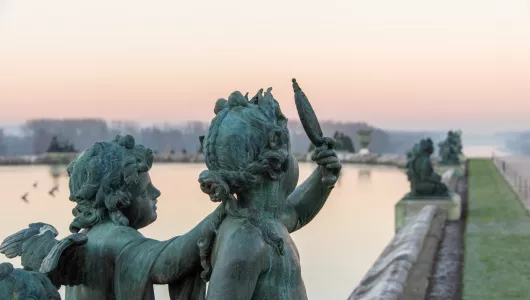
Become a patron
Individuals, companies, foundations, help the Palace of Versailles to shine worldwide. From just five euros, anyone can contribute to a patronage project and be part of the history of Versailles.
How to become a patron


